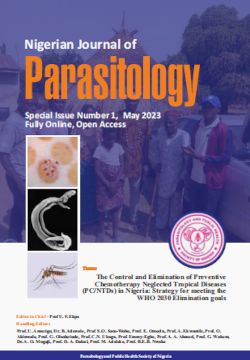Malaria parasitaemia among residents of Emohua Local Government Area and Port Harcourt Metropolis, Rivers State, Nigeria
http://dx.doi.org/10.4314/njpar.v40i1.5
Keywords:
Rivers State, Port Harcourt, Emohua, parasitaemia, MalariaAbstract
Malaria is responsible for significant cases of morbidity and mortality among children and pregnant women in sub-Saharan Africa. The study investigated the prevalence of malaria among residents of Emohua Local Government Area and Port Harcourt Metropolis, Rivers State, Nigeria. Four hundred randomly selected study participants were examined by oil immersion microscopy, using thick (stained with Field’s stains A and B) and thin (stained with 3% Giemsa) blood films. Data collected was statistically analyzed using descriptive statistics, t-test and chi- square test at 5% significance level. Plasmodium falciparum was the only species found in both study populations. An overall study of 44.3% was observed for malaria parasitaemia; Emohua and Port Harcourt had prevalence of 53% and 35.5% respectively (p<0.05). the overall malaria in relation to sex was 44.2% and 44.3% in females and males respectively (p>0.05); Emohua had prevalence of 55% and 50% for females and males respectively while Port Harcourt had 30.5% and 40% for females and males respectively (p<0.05). study participants in age group 10-12 years had the highest prevalence of 58%; Emohua and Port Harcourt had the highest prevalence in age groups 10-12 years (78.3%) and 16-18 years (50%) respectively (p<0.05). The study shows that malaria is still a significant public health problem in Emohua and Port Harcourt metropolis, there is need for sustained public awareness and effective control measures.
References
Cheesbrough, M. 2010. District Laboratory Practice in Tropical Countries. Part 1, Second Edition, pp. 239- 253.
Eze, E. M. 2015. Experimental relationship between malaria parasite density and some haematological parameters in malaria infected female subjects in Port Harcourt, Nigeria. Journal of Natural Sciences Research, 5 (16): 58-66.
Eze N. C., Sydney, O. N. and Nduka, F.O. 2014. Patterns of Plasmodium falciparum among Fulani Pastoralists in Rivers State, Nigeria. International Journal of Tropical Disease and Health, 4 (3): 295-305.
Fawole, O. I. and Onadeko, M. O. 2001. Knowledge and management of malaria in under five children by primary health care workers in Ibadan South East Local Government Area, Nigeria. Post Graduate Medical Journal, 8(1): 1-5.
Kalu, M. K., Nwogo A. O., Nduka, F.O. and Maria, O. O. 2012. Prevalence of malaria parasitaemia in Umuchieze and Uturu communities of Abia State, Nigeria. Asian Journal of Epidemiology, 5: 95-102.
Mbanugo, J. I. and Ejim, D. O. 2000. Plasmodium infection in children aged 0-5 years in Awka metropolis, Anambra State, Nigeria. Nigerian Journal of Parasitology, 2 (1): 55-59.
Nduka, F. O. 2015. Parasite vs Host: A Cat and Mouse Game. Inaugural lecture series. University of Port Harcourt. No. 120, pp. 10-11.
NMCP. 2012. Four out of ten Nigerian children have Malaria: New survey on Malaria prevalence among Nigerian children 2010. Released on Vanguard newspaper on February 28, 2012.
Nwaorgu, O. C. and Orajakana, B. N. 2011. Prevalence of malaria among children 1-10 years old in communities of Awka, Anambra State, South East Nigeria. International Multidisciplinary Journal Ethiopia, 5 (22): 264-265.
Nwibari, W.B. 2008. Studies on malaria and lymphatic filariasis in parts of Rivers State. Ph.D dissertation, Department of Animal and Environmental Biology, University of Port Harcourt, Nigeria, p. 100.
Udeze, A. O., Nwakocha, E. J., Okerentugba, P. O., Anibijuwon, I. I. and Okonko, I. O. 2013. Asymptomatic Plasmodium parasitaemia in Ilorin, North Central Nigeria. Nature and science. http://www.sciencepub.net/nature.
Verma, P. S. and Agarwal, V. K. 2010. Textbook of Cell Biology, Genetics, Molecular Biology, Evolution and Ecology. Chapter 10, p. 127.
World Health Organization. 1998. Malaria WHO Information Fact Sheet No. 94 Geneva, WHO Press Office, Switzerland, 1-6. Accessed: March, 2014.
World Health Organization Update. 2014. Malaria Fact Sheet No. 94. Geneva WHO Media office, Switzerland: 1-6. Accessed: March 2015.
Wogu, M. N., Nduka, F. O. and Wogu, M. D. 2013. Prevalence of malaria parasite among pregnant women attending antenatal clinics in Port Harcourt, Rivers State, Nigeria. International Journal of Tropical Disease and Health, 3(2): 126-132.
Zainab, G. and Zainab, T. 2014. Prevalence of malaria parasitaemia using Rapid Diagnostic Test among apparently healthy children in Kano, Nigeria. Journal of Medicine in the Tropics, 16 (1): 1-4.
Downloads
Published
How to Cite
Issue
Section
License

This work is licensed under a Creative Commons Attribution-NonCommercial-NoDerivatives 4.0 International License.





